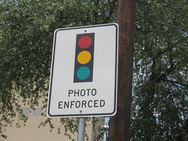How else can DC’s camera program improve safety?

Photo by fringehog on Flickr.
The District’s traffic camera program is a good idea and a very important initiative, but it won’t enjoy public support unless it’s clear to voters that safety is the goal, not revenue. A task force, which I’m serving on, will meet soon to formulate recommendations for Councilmembers Cheh and Wells.
Last week, I suggested some ways DC might identify the appropriate fine for speed, red light, and other cameras. In addition to the levels of fines, there are a few other ways we can ensure that the program serves safety first and works well.
We should make sure that drivers get a notice as fast as possible that they’ve gotten a ticket, so they can adjust behavior before getting one or ten more. Money from cameras could automatically fund more cameras, and projects to redesign the roadway to reduce speeding, red light running and more.
Notify drivers faster
A friend, who works outside the District in a car-dependent area, got 11 camera tickets before finding out about even the first one. If she was driving 11-15 miles over the speed limit, that would come out to $1,375 in fines. What does this achieve?
Since the goal of cameras needs to be getting people to obey speed limits, red lights, and other traffic laws, the quicker DC tells people they’ve gotten a ticket, the better. Psychologists call this “contiguity,” and found that whether one’s punishing animals, children or adult humans, the closer a punishment is to the infraction, the more effective the punishment.
We’d actually get the most behavior change if every time someone sped or ran a red light, a sign lit up a bit down the road saying, “You just got a ticket. Please don’t speed/run red lights.” However, this could anger and possibly distract drivers, and also, current cameras require a human to review each ticket to be sure it’s fair. Therefore, this is probably impractical.
However, we can ensure that the tickets come as quickly as possible. A bill around ensuring safety could require that the contractor mail tickets within a set period of time.
The DC DMV also has a system where you can sign up with an email address to get notified about tickets, deadlines for late penalties, and more. Unfortunately, right now you have to get a ticket and then use that ticket number to sign up with the system, “for privacy reasons.” At least for DC drivers, the DMV could sign up people for this service when they renew a car registration. Is there anything else that could be done for out-of-state drivers, besides having the DMVs of neighboring states work together?
Let MPD use camera money to buy new cameras
AS we discussed previously, more cameras with lower fines is a more effective way to get people to follow laws than fewer cameras with higher fines. In order to have more cameras with lower fines, however, DC needs to be able to buy more cameras.
The current crop of cameras MPD is ordering were in the pipeline for at least two years, and they’re still not in place. That’s largely a consequence of the procurement process. Even though the cameras bring in money, all of that money goes to the general fund. If MPD wants another camera or even if an existing one breaks, they need a line item in the annual capital budget specifically authorizing spending that amount of money on cameras.
There are reasons to budget this way. It forces more transparency and ensures that spending follows the priorities of the mayor and council. However, it also makes everything really, really slow.
A bill around cameras could give MPD the power to buy more cameras out of the revenue from other cameras. This would dovetail well with the suggestion from last week that fines automatically lower as more cameras come in. That way, safety improves, but drivers also get the reduction they want, and we maintain the overall balance of severity against certainty.
Use revenue for safety programs
There are other ways to make the streets safer. In particular, often the “design speed” of a road does not match the speed we want people to drive. For a long time, traffic engineers thought that it would be safest if they built every road to handle faster traffic than people actually wanted. The thinking went that if they did this, if a driver sped, they would still be able to avoid hitting a tree or something.
However, this created roads that sent psychological signals to drivers that they should travel faster. Drivers did, and a conventional wisdom evolved that faster driving was appropriate in that area. Standards evolved around setting a speed limit at the 85th percentile of how fast cars are traveling, which meant that the road design, which created a general practice, then became its own law.
To slow down traffic in residential areas, we can set lower speed limits, but most people ignore them. We can then put up cameras, but drivers will continue to feel tension between the signals they get from road design and the posted limits. The best way to solve this is to redesign the road with the right design speed.
There are many ways to reduce design speeds. Bulb-outs at corners reduce the distance pedestrians have to cross and create visual signals to travel slower. Cycle tracks reduce the visual width of a street. Bioswales, medians, and gently curving lanes (chicanes), like those suggested for C Street, NE, can add green features and slow traffic.
The camera law could mandate that camera revenue, over and above the revenue dedicated to the FY2013 budget and which doesn’t go to cameras, would go into a special fund that DDOT can use to redesign roadways. Those roadways need to be ones with speeding problems today, where the change reduces the design speed of the road.
What else would you suggest?
